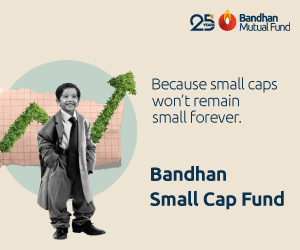Mid Cap valuations are reasonable and no longer trading at a premium
BFSI Industry Interview

Mr. Ankit Jain has professional experience of more than 8 years and his primary responsibility includes Investment Analysis & Fund Management. He has been associated with the AMC since September 2015. He is a fund manager of Mirae Asset Great Consumer Fund and co-fund manager of Mirae Asset Emerging Bluechip Fund along with Mr. Neelesh Surana since January 31, 2019. He was previously associated with Equirus Securities Pvt Ltd. and Infosys Ltd.
Mr. Jain is a Bachelor in Engineering from DAIICT, Gandhinagar and has done MBA in Finance from NMIMS University, Mumbai.
After the pre-election rally, the stock market has been range bound over the past month or so. There are concerns of slowdown in economic growth. What is your outlook on corporate earnings over the next few quarters? What is your outlook on the equity market in India over the next 3 years or so?
Yes, there has been some softness in the underlying economic growth which is also reflected in the last quarter GDP growth numbers as the same has slowed down to 5.8%. While we believe consumption led growth slowdown might persist for another 1-2 quarters as liquidity constraints and rural slowdown continues. Though, we see strong earnings growth in FY20 led by mean reversion in earnings of financial sector. Overall we remain constructive on the Indian market as we are coming out of an era of low earnings growth; higher earnings growth going ahead will drive returns in the market in the medium term.
Crude oil prices are shooting up due to rising tension in the Persian Gulf region. How will it impact us, particularly in terms of inflation and fiscal deficit?
Crude oil price has been fairly stable in the range of $60-70/barrel over past 1 year, except for a brief period when it has trended downwards at around $50/barrel mark. Given import dependence and Govt subsidy, significant increase in crude oil prices impacts fiscal deficit and inflation. Though, impact of crude price on inflation and fiscal deficit has reduced significantly. For example, every 10% rise in crude prices will lead to 20-40bps higher inflation (taking into both direct as well as indirect impact). With regards to fiscal, petroleum subsidies are ~0.2% of GDP. Hence, even if crude oil prices rise higher, the impact on fiscal deficit would be lower, unless if there is reduction in excise duty on petrol and diesel.
RBI has cut repo rates three times in a row and in its last MPC meeting hinted that they are ready to reduce rates even further. What is your view on interest rates? When do you expect to see lower interest rates translate into increased private sector borrowing?
Yes, there have been 3 rate cuts (equivalent to 75bps) over last 5 months. RBI accommodative stance emanate from benign inflation and lowering of global rate cycle. Despite of rate cuts, transmission of lower interest rates to the end market has been fairly low because of ongoing liquidity tightness. Increased private sector borrowing depends on lot of other factors such as fiscal policy, domestic and exports demand outlook apart from lower interest rates. We believe further rate cuts, accompanied by strong liquidity injection could help in increased private sector borrowings in the medium term.
What are thoughts on the asset liability situation in NBFCs and the likely way forward out of current situation?
The liquidity challenge for NBFCs is reflecting both in the availability and cost of funds (spreads over T bills). The dependence on short term money has been reducing in favour of bank borrowings. While this trend to continue, smaller NBFCs & HFCs will continue to find it difficult to raise funds given limited risk appetite among banks to lend.
What is your outlook on the consumer sector stocks particularly in the midcap segment of the market in the medium to long term (3 – 5 years)?
Consumption theme in India is a very structural one led by favourable demographics and rising per capita income. This is a multi-decadal theme which will be driven by rising penetration, premiumization and demand shift from unorganized to organized sector. In the near term, a combination of liquidity squeeze, slower rural income growth, and disruption due to general election has impacted growth in the last 1 quarter. We expect situation to normalize over next 1-2 quarters and expect solid growth momentum to continue in the medium term. Mid-sizes companies in the consumer sector have got impacted more during demonetisation and GST transition and underperformed their larger peers. Since then, most of these players have improved upon their distribution network by increasing direct reach, technological upgradation etc to capitalize on these regulations. We do see good value in the certain B2C midcap companies.
Midcap stocks have recovered from February lows, but they are still substantially down from the January 2018 all time high. Do you think high quality midcap stocks are selling at attractive prices now? Is this a good time for investors who may have exited midcap funds in 2018 or investors with lump sum money to invest in midcaps again?
Typically historical revenue/earnings growth of mid cap has always outperformed large-cap but over a longer time frame (say 5 years+). In last 1 year, mid-caps has under-performed large cap by 17% (mid-cap -6% YoY Vs large-cap +11% YoY) despite of mid-cap earnings growth of 30% Vs large-cap of 7% during FY19. This has resulted in mid-caps trading at ~15-20% discount (Vs historical average discount of around 8%) to large-cap in comparison to 40% premium around 18 months back. This suggests that now mid-cap valuations are reasonable. However, difficult to say if this is bottom but certainly can say that they are reasonable and no longer trading at a premium.
What is your investment approach towards picking midcap stocks for your equity funds?
Our Stock selection process has three aspects: Business selection, Management analysis, and valuation. We look of quality businesses with decent growth prospects as well as return characteristics (i.e. Return on capital employed - ROCE). This is a crucial initial filter. Second filter is with respect to management analysis, which is a bit subjective but you have to look at the track record and corporate governance. A well-managed company will have better capital efficiency so the (Return on Equity) ROE's tend to be better than other companies in the same sector. The last factor is to arrive at a particular value. Value has to be more than the market price so that there is enough 'Margin of Safety'. The idea is not to buy cheap companies, but good companies at reasonable valuation.
You sought SEBI’s approval for a new midcap fund. What is the status? Can we expect you to launch your midcap NFO soon?
Yes, we have got SEBI’s approval to launch a new midcap fund. NFO for the same is starting from Jul 8th onwards.
What is your advice for retail investors who have invested in midcap funds or want to invest in midcap funds?
Given inherent nature of higher earnings volatility in midcap asset class Vs large-cap, investors should have relatively longer time horizon (typically 4-5 year) while investing in mid-caps and investing in a staggered manner will lead to better investment experience.
Recent Interviews
-
Partner Connect by Advisorkhoj with Mr Amit Kalra Glorious Path Pvt Ltd New Delhi
Dec 5, 2025
-
Partner Connect by Advisorkhoj with Mr Alok Dubey PrimeWealth Pune
Dec 1, 2025
-
In Conversation by Advisorkhoj with Ms Aparna Shanker Chief Investment Officer Equity The Wealth Company Mutual Fund
Nov 28, 2025
-
In Conversation by Advisorkhoj with Mr Sanjay Bembalkar Head Equity Union MF
Nov 28, 2025
-
In Conversation by Advisorkhoj with Mr Arjun Khanna Equity Fund Manager Kotak Mutual Fund
Nov 17, 2025
Fund News
-
DSP Mutual Fund launches DSP Nifty Next 50 ETF
Dec 19, 2025 by Advisorkhoj Team
-
DSP Mutual Fund launches DSP Nifty 500 Index Fund
Dec 19, 2025 by Advisorkhoj Team
-
Kotak Mahindra Mutual Fund launches Kotak Nifty Next 50 ETF
Dec 18, 2025 by Advisorkhoj Team
-
The Wealth Company Mutual Fund launches The Wealth Company Gold ETF
Dec 16, 2025 by Advisorkhoj Team
-
Axis Mutual Fund launches Axis Gold and Silver Passive FOF
Dec 10, 2025 by Advisorkhoj Team





